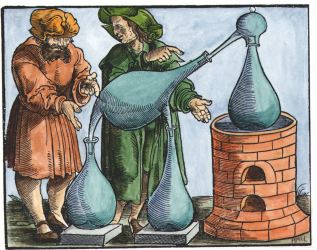| Author | Post |
|---|
alchemyd
Administrator
|
Posted: Tue Mar 11th, 2014 03:53 pm |
|
A contact recently asked me :
I was wondering if you knew something on the origins of the pelican flask? Most of the illustrations I have found date to the 16th century, and none mention the origin
Does anyone know where the earliest illustrations of pelican flasks can be found ?
|
Alexander Guthrie Stewart
Member
| Joined: | Sat Feb 16th, 2008 |
| Location: | |
| Posts: | 192 |
| Status: |
Offline
|
|
Posted: Tue Mar 11th, 2014 08:38 pm |
|
I think there's one in the Nortons Ordinal illustration, MS 10302, late 15th century, the one which has the balance on a table in a glass case. At the front are two men tending furnaces, the one on the right looks like a 2 necked pelican.
The earliest description I know of is John of Rupescissa's On the fifth essence, which describes a pelican like device with arms, plural, which would fit the description, but alas, no illustration.
There's numerous marginal drawings in medieval MS in the BL (and elsewhere), but nobody seems to have had time to go through them all. I'd love to but alas, lack of time and money. But I suspect there might be some pictures lurking within them.
|
adammclean
Member

| Joined: | Fri Sep 14th, 2007 |
| Location: | United Kingdom |
| Posts: | 606 |
| Status: |
Offline
|
|
Posted: Tue Mar 11th, 2014 09:54 pm |
|
| There are a number of woodcut illustrations of pelican flasks in Braunschweig's Book on Distillation printed in 1500. I am sure I have seen a number of drawings in 15th century manuscripts.
|
adammclean
Member

| Joined: | Fri Sep 14th, 2007 |
| Location: | United Kingdom |
| Posts: | 606 |
| Status: |
Offline
|
|
Posted: Tue Mar 11th, 2014 10:13 pm |
|
I am not sure I see an actual pelican flask in the Norton engravings or in the earlier manuscript drawing which this copies.
The pelican bird appears in early manuscripts, the Constantinius (late XIVth) and the Aurora consurgens, though the flask form is not depicted there.
The flask form may be an abstraction, a thought experiment, rather than a practical piece of apparatus. After all, without drawing a vacuum, upon heating any material sealed in the pelican, this would likely expand and probably explode the glass. In any case one would have to destroy the glassware to gain access to the product of the distillation, so this is also impractical. In practice, continually recirculating a distillation would likely be easier using a conventional alembic with a removable still head.
|
Paul Ferguson
Member

| Joined: | Fri Feb 15th, 2008 |
| Location: | |
| Posts: | 1538 |
| Status: |
Offline
|
|
Posted: Tue Mar 11th, 2014 10:34 pm |
|
Distillation apparatus from the Han dynasty, dated around the first century AD.
From:
R. Arnaldez & R. Taton, La Science antique et medievale, Presses Universitaires de France, Paris, 1957, plate 16. Photo: Sir J. Needham.
Attached Image (viewed 1897 times):
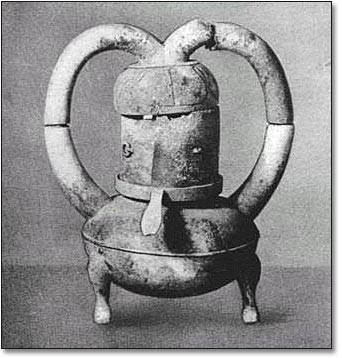 Last edited on Wed Mar 12th, 2014 02:06 am by Paul Ferguson
|
adammclean
Member

| Joined: | Fri Sep 14th, 2007 |
| Location: | United Kingdom |
| Posts: | 606 |
| Status: |
Offline
|
|
Posted: Tue Mar 11th, 2014 11:35 pm |
|
| It is interesting to see how this Chinese pelican appears to be constructed out of components that are somehow linked together. If this is made of pottery then these joints could have been luted with clay.
|
Alexander Guthrie Stewart
Member
| Joined: | Sat Feb 16th, 2008 |
| Location: | |
| Posts: | 192 |
| Status: |
Offline
|
|
Posted: Wed Mar 12th, 2014 08:04 pm |
|
I had a glass pelican, admittedly pyrex, and it worked fine for hours of circulation, then I let the heat get a bit high and it did explode.
The Norton illumination looks to me like a pelican because it has an alembic type top, with a knob at the top of that which may be an inlet. Then there's two arms going back down into the reaction vessel.
Of course if it isn't a pelican, it becomes necessary to explain why the artist managed a scientific balance, several furnaces and normal distillation apparatus perfectly well (for the time) and yet made an alembic have 2 funnels leading back to the lower vessel.
Also the Ripley scrolls have similar items in them.
The more joint the greater the chance of escape of contents, but it makes sense that the earliest such devices would be made of pottery.
|
adammclean
Member

| Joined: | Fri Sep 14th, 2007 |
| Location: | United Kingdom |
| Posts: | 606 |
| Status: |
Offline
|
|
Posted: Wed Mar 12th, 2014 08:27 pm |
|
Alexander Guthrie Stewart wrote:
I had a glass pelican, admittedly pyrex, and it worked fine for hours of circulation,
How did you seal the pelican once you had put the materials in it ?
|
adammclean
Member

| Joined: | Fri Sep 14th, 2007 |
| Location: | United Kingdom |
| Posts: | 606 |
| Status: |
Offline
|
|
Posted: Wed Mar 12th, 2014 09:42 pm |
|
| Here is the illustration from the British Library manuscript.
|
adammclean
Member

| Joined: | Fri Sep 14th, 2007 |
| Location: | United Kingdom |
| Posts: | 606 |
| Status: |
Offline
|
|
Posted: Wed Mar 12th, 2014 09:43 pm |
|
| Here is the illustration from the British Library manuscript. Attached Image (viewed 1370 times):
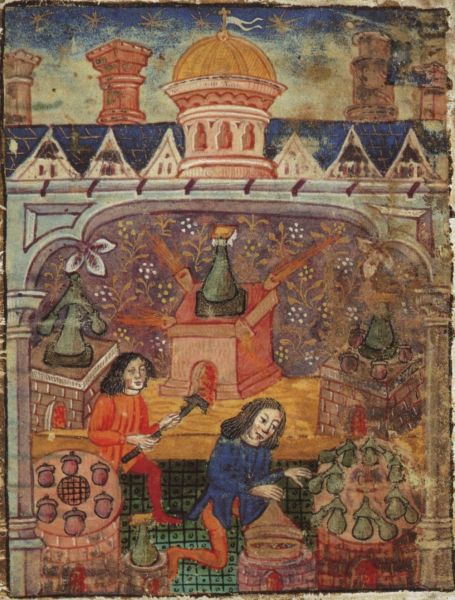
|
Paul Ferguson
Member

| Joined: | Fri Feb 15th, 2008 |
| Location: | |
| Posts: | 1538 |
| Status: |
Offline
|
|
Posted: Thu Mar 13th, 2014 02:04 am |
|
This seems to be an interesting book. Part IV has a lot of information on the history of distillation:
http://chestofbooks.com/health/aromatherapy/The-Volatile-Oils-Vol1/index.html#.UyEDqfkhBa8
|
adammclean
Member

| Joined: | Fri Sep 14th, 2007 |
| Location: | United Kingdom |
| Posts: | 606 |
| Status: |
Offline
|
|
Posted: Thu Mar 13th, 2014 11:42 am |
|
Sorry I posted the wrong image above.
I don't have a scan of the correct image from the British Library manuscript, but here is the later 17th century engraving which appears to have been made from the manuscript.Attached Image (viewed 1459 times):
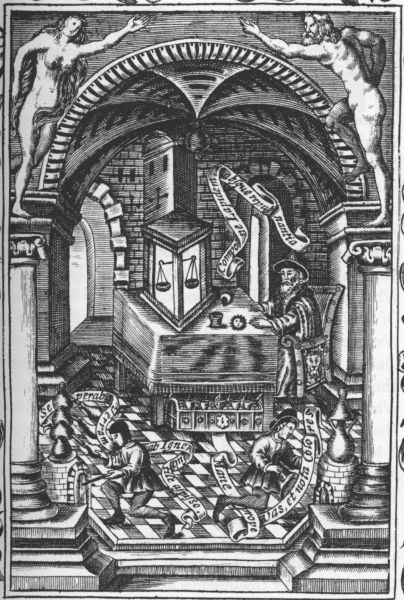 Last edited on Thu Mar 13th, 2014 11:42 am by adammclean
|
Paul Ferguson
Member

| Joined: | Fri Feb 15th, 2008 |
| Location: | |
| Posts: | 1538 |
| Status: |
Offline
|
|
Posted: Thu Mar 13th, 2014 01:11 pm |
|
| It's in the French Wikipedia entry on Norton. Attached Image (viewed 1303 times):
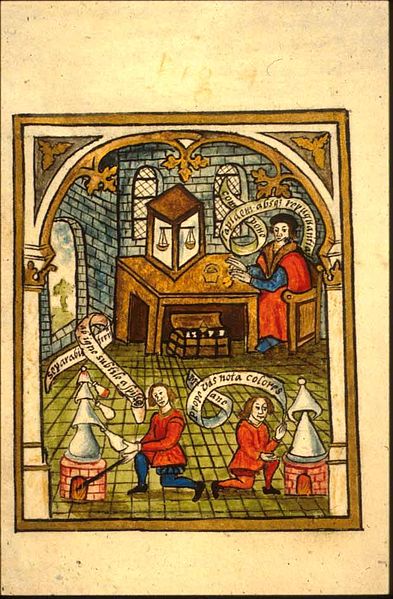
|
Alexander Guthrie Stewart
Member
| Joined: | Sat Feb 16th, 2008 |
| Location: | |
| Posts: | 192 |
| Status: |
Offline
|
|
Posted: Fri Mar 14th, 2014 12:14 am |
|
A modern quick-fit glass seal, cheating I know, which is one reason it exploded, because I luted it on too strongly. But I did find that you could keep it in place with some care for a while, if you got the heat right, but after 10 or 20 minutes or whatever I'd invariably get it wrong and it would pop out. The book of the quintessence mentions a hole in the head of the flask.
So I maintain that if you managed to use a good sealant and control the fire properly you could get a good balance of vapour and condensation without actually losing the stopper or blowing it up.
Remember, nobody said this was easy!
In fact I suspect that glassware and operations evolved in concert with improved and changing furnace technology. Making a decent argument for it though is a bit harder and would require lots of research.
|
adammclean
Member

| Joined: | Fri Sep 14th, 2007 |
| Location: | United Kingdom |
| Posts: | 606 |
| Status: |
Offline
|
|
Posted: Mon Mar 31st, 2014 04:18 pm |
|
| Regarding the failure of glassware I paste in this extract from Samuel Norton's manuscript on The Key of Alchemy, which I am about to issue as a printed book. At the end of the manuscript is a list of the glassware and other materials necessary for the alchemical work. Clearly the number of items he suggested that one needed for the work reflected the expected losses. It is also interesting that he has priced each item Attached Image (viewed 1286 times):
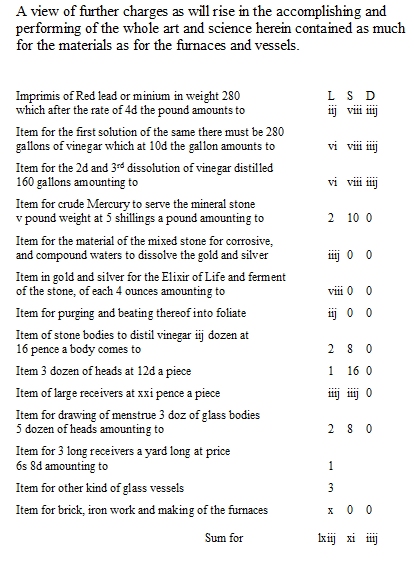 Last edited on Mon Mar 31st, 2014 04:18 pm by adammclean
|

Current time is 09:38 am | Page: 1 2   |
|
